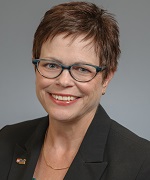 Karen Kervin, U.S. Bank
Karen Kervin, U.S. Bank
Title: Vice President, Community Relations Manager - Northwest Region
On the job since: 2013
Based in: Portland, Oregon
Corporate headquarters: Minneapolis, Minnesota
Philanthropic activity footprint: Portland, Seattle and surrounding communities
Grants made in 2015: $25.4 million nationally
Staffing for philanthropic activity: 3 FTE (Oregon and Washington)
How has your career prepared you for your current role?
I worked in the legal industry prior to my role with U.S. Bank. As chief marketing officer of a large Northwest law firm, I learned how to work with internal and external stakeholders to help the organization reach its goals. This is exactly what I do as community relations manager with U.S. Bank.
How are your bank's philanthropic activities — i.e., grants, impact investments, sponsorships, volunteerism — structured?
U.S. Bank's philanthropic activities are decentralized, which allows for local decision making by senior leaders in each region and community where we have a presence. Our national foundation provides guidance and oversight of all activities and grants, but allows local leaders to make decisions based on the needs of their communities.
How has this work changed since the Great Recession?
Our work has not changed since the Great Recession and giving levels have remained stable.
What are the most important issues in the communities where you engage in philanthropy?
U.S. Bank Foundation's national giving platform is called Community Possible. Our three pillars of giving are Work, Home and Play. These giving priorities were launched in early 2016, after extensive internal and external stakeholder research regarding issues that make the most sense for the bank and also meet the needs of the communities where we are located.
What are your core strategies for addressing these issues?
By focusing on the Work, Home and Play giving priorities, we will help people gain the skills needs to get a stable, living wage job, to get and maintain affordable housing, and to create access to artistic and cultural activities that make our communities more livable and help us all learn more about and interact with our friends and neighbors.
What's been a big success for your bank's philanthropic activity?
Our recent launch of Community Possible was very exciting for us. A more focused giving platform allows us to deploy our resources in a way that makes sense for a bank and to have greater impact to address the needs we've identified as most pressing for our communities.
What's a big challenge for your philanthropic activities?
A decentralized structure of giving means that we have many people within the bank making decisions about grants. This is an advantage, since local leaders know their communities best. This structure also means that we engage in a lot of training and coaching to help our leaders make good funding decisions that fit within the three pillars of Community Possible.
What’s one more question we should ask, and how would you answer it?
Q. What do you hope to receive as far as programs or services from Philanthropy Northwest?
A. We look forward to finding ways that various philanthropic organizations in the Northwest may be able to complement U.S. Bank's foundation giving with grant making programs that could further assist the nonprofit organizations with which we work.
Karen Kervin is a vice president and community relations manager for the Northwest region at U.S. Bank, joining us this month for our virtual roundtable with philanthropic banks. Philanthropy Northwest welcomes U.S. Bank to our network in 2016!